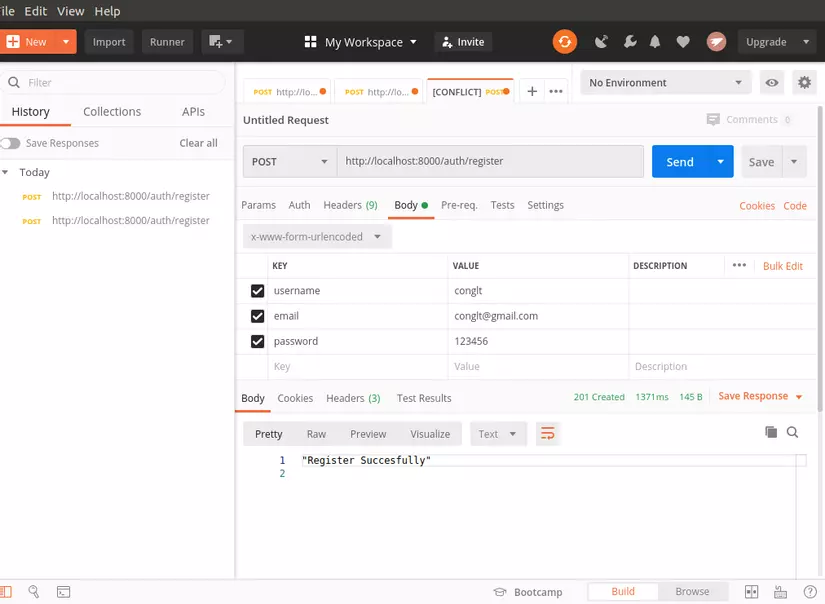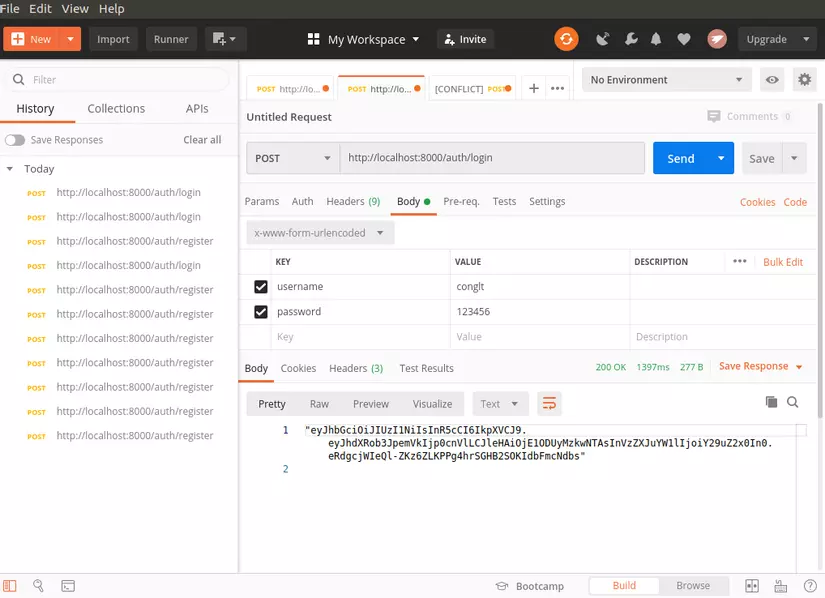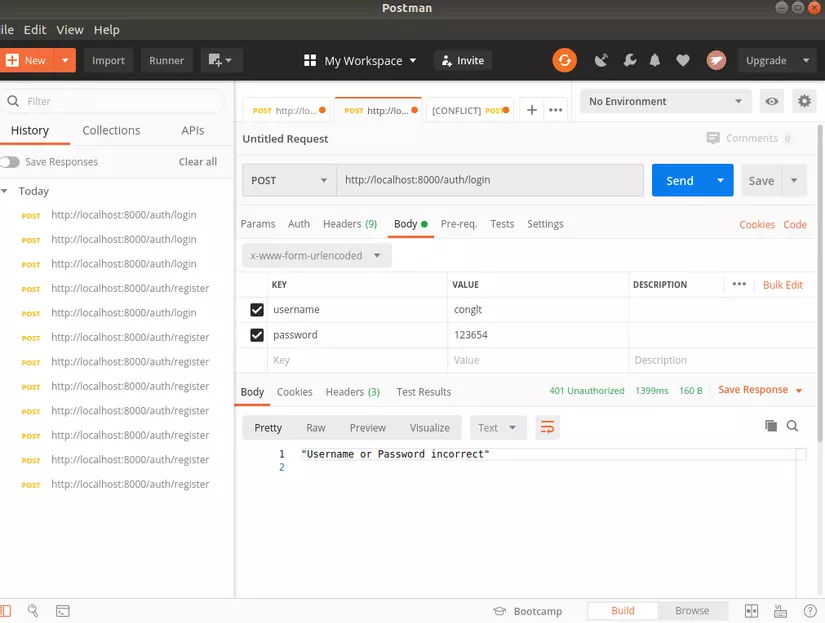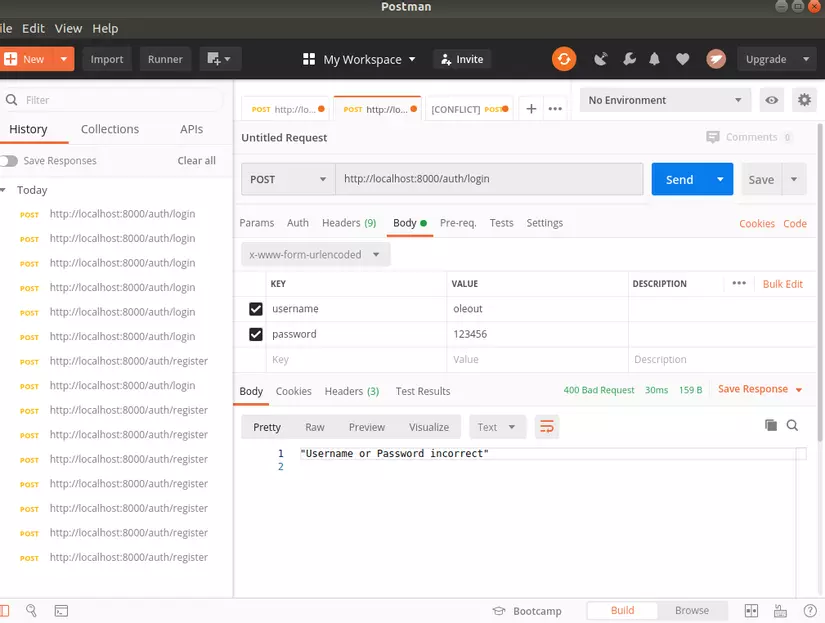
We will learn how to write registration, login, and authentication functions with json web token with Golang and MongoDB database. The full source of this article you can refer to here
1. Initialize directory
1 2 3 4 5 6 | <span class="token function">mkdir</span> web-golang <span class="token function">cd</span> web-golang <span class="token function">mkdir</span> server <span class="token function">cd</span> server go mod init github.com/conglt10/web-golang |
The go mod init [tên-module] command will create a file called go.mod , which will help manage the application’s packages. It is similar to implementing npm init inside Javascript and the go.mod file is similar to the package.json file
2. Directory structure
The directory structure will be organized as follows
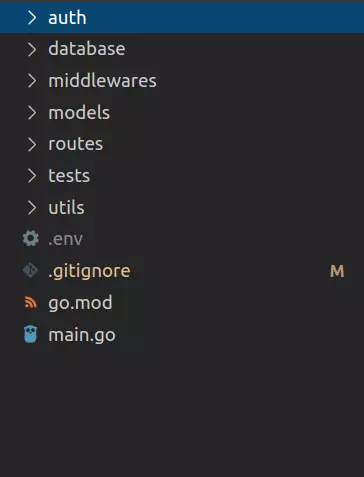
- The
main.gofile is the file we set the general specifications for the server, when running the application, it will run this file. - The
go.modfile manages how the package (as introduced above). .envstores application environment variables –authcontaining json web token handling filedatabasecontains files tasked with manipulating MongoDB (connect the database).modelsdefines the data structure to be saved in a collection.routescontain request handler functions for each routetestscontain unit test filesutilscontains some processing functions to use (parse JSON, …)
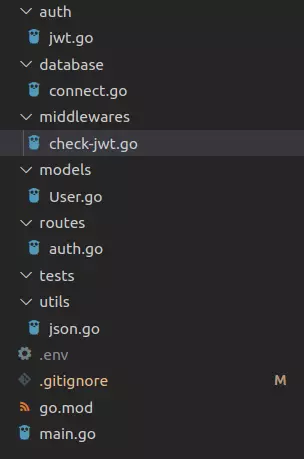
3. Coding Login and Register
main.go
1 2 3 4 5 6 7 8 9 10 11 12 13 14 15 16 17 18 19 20 21 22 23 24 25 26 | <span class="token keyword">package</span> main <span class="token keyword">import</span> <span class="token punctuation">(</span> <span class="token string">"fmt"</span> <span class="token string">"log"</span> <span class="token string">"net/http"</span> <span class="token string">"github.com/julienschmidt/httprouter"</span> <span class="token string">"github.com/joho/godotenv"</span> <span class="token string">"github.com/conglt10/web-golang/routes"</span> <span class="token punctuation">)</span> <span class="token keyword">func</span> <span class="token function">main</span> <span class="token punctuation">(</span> <span class="token punctuation">)</span> <span class="token punctuation">{</span> err <span class="token operator">:=</span> godotenv <span class="token punctuation">.</span> <span class="token function">Load</span> <span class="token punctuation">(</span> <span class="token punctuation">)</span> <span class="token keyword">if</span> err <span class="token operator">!=</span> <span class="token boolean">nil</span> <span class="token punctuation">{</span> log <span class="token punctuation">.</span> <span class="token function">Fatalf</span> <span class="token punctuation">(</span> <span class="token string">"Error getting env, %v"</span> <span class="token punctuation">,</span> err <span class="token punctuation">)</span> <span class="token punctuation">}</span> router <span class="token operator">:=</span> httprouter <span class="token punctuation">.</span> <span class="token function">New</span> <span class="token punctuation">(</span> <span class="token punctuation">)</span> router <span class="token punctuation">.</span> <span class="token function">POST</span> <span class="token punctuation">(</span> <span class="token string">"/auth/login"</span> <span class="token punctuation">,</span> auth <span class="token punctuation">.</span> Login <span class="token punctuation">)</span> router <span class="token punctuation">.</span> <span class="token function">POST</span> <span class="token punctuation">(</span> <span class="token string">"/auth/register"</span> <span class="token punctuation">,</span> auth <span class="token punctuation">.</span> Register <span class="token punctuation">)</span> fmt <span class="token punctuation">.</span> <span class="token function">Println</span> <span class="token punctuation">(</span> <span class="token string">"Listening to port 8000"</span> <span class="token punctuation">)</span> log <span class="token punctuation">.</span> <span class="token function">Fatal</span> <span class="token punctuation">(</span> http <span class="token punctuation">.</span> <span class="token function">ListenAndServe</span> <span class="token punctuation">(</span> <span class="token string">":8000"</span> <span class="token punctuation">,</span> router <span class="token punctuation">)</span> <span class="token punctuation">)</span> <span class="token punctuation">}</span> |
- The first line of the
mainfunction body uses the godotenv library so that the application can extract environment variables. - The following section simply checks for errors.
- Our application will use the
Multiplexerhttp / router instead of the defaultMultiplexerin thenet/httplibrary. - The next 2 lines define 2 routes used to login and register. The handling functions of the corresponding routes are
LoginandRegisterin theauthpackage (folder routes). - The server will listen on port 8000
models/User.go : Define the data structure in db
1 2 3 4 5 6 7 8 9 10 11 12 13 14 15 16 17 18 19 20 21 22 23 24 25 26 27 28 29 | <span class="token keyword">package</span> models <span class="token keyword">import</span> <span class="token punctuation">(</span> <span class="token string">"html"</span> <span class="token string">"strings"</span> <span class="token string">"golang.org/x/crypto/bcrypt"</span> <span class="token punctuation">)</span> <span class="token keyword">type</span> User <span class="token keyword">struct</span> <span class="token punctuation">{</span> username <span class="token builtin">string</span> email <span class="token builtin">string</span> password <span class="token builtin">string</span> <span class="token punctuation">}</span> <span class="token keyword">func</span> <span class="token function">Hash</span> <span class="token punctuation">(</span> password <span class="token builtin">string</span> <span class="token punctuation">)</span> <span class="token punctuation">(</span> <span class="token builtin">string</span> <span class="token punctuation">,</span> <span class="token builtin">error</span> <span class="token punctuation">)</span> <span class="token punctuation">{</span> bytes <span class="token punctuation">,</span> err <span class="token operator">:=</span> bcrypt <span class="token punctuation">.</span> <span class="token function">GenerateFromPassword</span> <span class="token punctuation">(</span> <span class="token punctuation">[</span> <span class="token punctuation">]</span> <span class="token function">byte</span> <span class="token punctuation">(</span> password <span class="token punctuation">)</span> <span class="token punctuation">,</span> <span class="token number">14</span> <span class="token punctuation">)</span> <span class="token keyword">return</span> <span class="token function">string</span> <span class="token punctuation">(</span> bytes <span class="token punctuation">)</span> <span class="token punctuation">,</span> err <span class="token punctuation">}</span> <span class="token keyword">func</span> <span class="token function">CheckPasswordHash</span> <span class="token punctuation">(</span> hashedPassword <span class="token punctuation">,</span> password <span class="token builtin">string</span> <span class="token punctuation">)</span> <span class="token builtin">error</span> <span class="token punctuation">{</span> <span class="token keyword">return</span> bcrypt <span class="token punctuation">.</span> <span class="token function">CompareHashAndPassword</span> <span class="token punctuation">(</span> <span class="token punctuation">[</span> <span class="token punctuation">]</span> <span class="token function">byte</span> <span class="token punctuation">(</span> hashedPassword <span class="token punctuation">)</span> <span class="token punctuation">,</span> <span class="token punctuation">[</span> <span class="token punctuation">]</span> <span class="token function">byte</span> <span class="token punctuation">(</span> password <span class="token punctuation">)</span> <span class="token punctuation">)</span> <span class="token punctuation">}</span> <span class="token keyword">func</span> <span class="token function">Santize</span> <span class="token punctuation">(</span> data <span class="token builtin">string</span> <span class="token punctuation">)</span> <span class="token builtin">string</span> <span class="token punctuation">{</span> data <span class="token operator">=</span> html <span class="token punctuation">.</span> <span class="token function">EscapeString</span> <span class="token punctuation">(</span> strings <span class="token punctuation">.</span> <span class="token function">TrimSpace</span> <span class="token punctuation">(</span> data <span class="token punctuation">)</span> <span class="token punctuation">)</span> <span class="token keyword">return</span> data <span class="token punctuation">}</span> |
- Basic
Userstructure consists of 3usernamefields,emailandpassword - The
Hashfunction passes the string password, then passes theGenerateFromPasswordfunction of the brcypt library to hash. Below is the prototyped of theGenerateFromPasswordfunction.
1 2 | <span class="token keyword">func</span> <span class="token function">GenerateFromPassword</span> <span class="token punctuation">(</span> password <span class="token punctuation">[</span> <span class="token punctuation">]</span> <span class="token builtin">byte</span> <span class="token punctuation">,</span> cost <span class="token builtin">int</span> <span class="token punctuation">)</span> <span class="token punctuation">(</span> <span class="token punctuation">[</span> <span class="token punctuation">]</span> <span class="token builtin">byte</span> <span class="token punctuation">,</span> <span class="token builtin">error</span> <span class="token punctuation">)</span> |
CheckPasswordHashtheCheckPasswordHashfunction compare the submitted user password match the hashed password in the database?
1 2 | <span class="token keyword">func</span> <span class="token function">CompareHashAndPassword</span> <span class="token punctuation">(</span> hashedPassword <span class="token punctuation">,</span> password <span class="token punctuation">[</span> <span class="token punctuation">]</span> <span class="token builtin">byte</span> <span class="token punctuation">)</span> <span class="token builtin">error</span> |
Santizefunction to remove extra spaces, encode special characters of the data (avoid partial injection holes) before saving to the db.
database/connect.go : Connect to the database
1 2 3 4 5 6 7 8 9 10 11 12 13 14 15 16 17 18 19 20 21 22 23 24 25 26 27 28 29 | <span class="token keyword">package</span> db <span class="token keyword">import</span> <span class="token punctuation">(</span> <span class="token string">"log"</span> <span class="token string">"context"</span> <span class="token string">"os"</span> <span class="token string">"go.mongodb.org/mongo-driver/mongo"</span> <span class="token string">"go.mongodb.org/mongo-driver/mongo/options"</span> <span class="token punctuation">)</span> <span class="token keyword">func</span> <span class="token function">Connect</span> <span class="token punctuation">(</span> <span class="token punctuation">)</span> <span class="token operator">*</span> mongo <span class="token punctuation">.</span> Collection <span class="token punctuation">{</span> clientOptions <span class="token operator">:=</span> options <span class="token punctuation">.</span> <span class="token function">Client</span> <span class="token punctuation">(</span> <span class="token punctuation">)</span> <span class="token punctuation">.</span> <span class="token function">ApplyURI</span> <span class="token punctuation">(</span> os <span class="token punctuation">.</span> <span class="token function">Getenv</span> <span class="token punctuation">(</span> <span class="token string">"MONGODB_URI"</span> <span class="token punctuation">)</span> <span class="token punctuation">)</span> client <span class="token punctuation">,</span> err <span class="token operator">:=</span> mongo <span class="token punctuation">.</span> <span class="token function">Connect</span> <span class="token punctuation">(</span> context <span class="token punctuation">.</span> <span class="token function">TODO</span> <span class="token punctuation">(</span> <span class="token punctuation">)</span> <span class="token punctuation">,</span> clientOptions <span class="token punctuation">)</span> <span class="token keyword">if</span> err <span class="token operator">!=</span> <span class="token boolean">nil</span> <span class="token punctuation">{</span> log <span class="token punctuation">.</span> <span class="token function">Fatal</span> <span class="token punctuation">(</span> err <span class="token punctuation">)</span> <span class="token punctuation">}</span> <span class="token comment">// Check the connection</span> err <span class="token operator">=</span> client <span class="token punctuation">.</span> <span class="token function">Ping</span> <span class="token punctuation">(</span> context <span class="token punctuation">.</span> <span class="token function">TODO</span> <span class="token punctuation">(</span> <span class="token punctuation">)</span> <span class="token punctuation">,</span> <span class="token boolean">nil</span> <span class="token punctuation">)</span> <span class="token keyword">if</span> err <span class="token operator">!=</span> <span class="token boolean">nil</span> <span class="token punctuation">{</span> log <span class="token punctuation">.</span> <span class="token function">Fatal</span> <span class="token punctuation">(</span> err <span class="token punctuation">)</span> <span class="token punctuation">}</span> collection <span class="token operator">:=</span> client <span class="token punctuation">.</span> <span class="token function">Database</span> <span class="token punctuation">(</span> <span class="token string">"golang"</span> <span class="token punctuation">)</span> <span class="token punctuation">.</span> <span class="token function">Collection</span> <span class="token punctuation">(</span> <span class="token string">"users"</span> <span class="token punctuation">)</span> <span class="token keyword">return</span> collection <span class="token punctuation">}</span> |
As in the previous article, we connect to mongoDB right in the main function and execute the query. However, this is not suitable for writing module splits because other functions in the other package will not use the collection object returned when the connection is successful. Therefore, we will write the connect to DB function in a separate package and the function can be called at any time to execute.
utils/json.go
1 2 3 4 5 6 7 8 9 10 11 12 13 14 15 16 17 18 19 20 21 22 23 24 25 26 27 28 29 | <span class="token keyword">package</span> res <span class="token keyword">import</span> <span class="token punctuation">(</span> <span class="token string">"encoding/json"</span> <span class="token string">"fmt"</span> <span class="token string">"net/http"</span> <span class="token punctuation">)</span> <span class="token keyword">func</span> <span class="token function">JSON</span> <span class="token punctuation">(</span> w http <span class="token punctuation">.</span> ResponseWriter <span class="token punctuation">,</span> statusCode <span class="token builtin">int</span> <span class="token punctuation">,</span> data <span class="token keyword">interface</span> <span class="token punctuation">{</span> <span class="token punctuation">}</span> <span class="token punctuation">)</span> <span class="token punctuation">{</span> w <span class="token punctuation">.</span> <span class="token function">WriteHeader</span> <span class="token punctuation">(</span> statusCode <span class="token punctuation">)</span> err <span class="token operator">:=</span> json <span class="token punctuation">.</span> <span class="token function">NewEncoder</span> <span class="token punctuation">(</span> w <span class="token punctuation">)</span> <span class="token punctuation">.</span> <span class="token function">Encode</span> <span class="token punctuation">(</span> data <span class="token punctuation">)</span> <span class="token keyword">if</span> err <span class="token operator">!=</span> <span class="token boolean">nil</span> <span class="token punctuation">{</span> fmt <span class="token punctuation">.</span> <span class="token function">Fprintf</span> <span class="token punctuation">(</span> w <span class="token punctuation">,</span> <span class="token string">"%s"</span> <span class="token punctuation">,</span> err <span class="token punctuation">.</span> <span class="token function">Error</span> <span class="token punctuation">(</span> <span class="token punctuation">)</span> <span class="token punctuation">)</span> <span class="token punctuation">}</span> <span class="token punctuation">}</span> <span class="token keyword">func</span> <span class="token function">ERROR</span> <span class="token punctuation">(</span> w http <span class="token punctuation">.</span> ResponseWriter <span class="token punctuation">,</span> statusCode <span class="token builtin">int</span> <span class="token punctuation">,</span> err <span class="token builtin">error</span> <span class="token punctuation">)</span> <span class="token punctuation">{</span> <span class="token keyword">if</span> err <span class="token operator">!=</span> <span class="token boolean">nil</span> <span class="token punctuation">{</span> <span class="token function">JSON</span> <span class="token punctuation">(</span> w <span class="token punctuation">,</span> statusCode <span class="token punctuation">,</span> <span class="token keyword">struct</span> <span class="token punctuation">{</span> Error <span class="token builtin">string</span> <span class="token string">`json:"error"`</span> <span class="token punctuation">}</span> <span class="token punctuation">{</span> Error <span class="token punctuation">:</span> err <span class="token punctuation">.</span> <span class="token function">Error</span> <span class="token punctuation">(</span> <span class="token punctuation">)</span> <span class="token punctuation">,</span> <span class="token punctuation">}</span> <span class="token punctuation">)</span> <span class="token keyword">return</span> <span class="token punctuation">}</span> <span class="token function">JSON</span> <span class="token punctuation">(</span> w <span class="token punctuation">,</span> http <span class="token punctuation">.</span> StatusBadRequest <span class="token punctuation">,</span> <span class="token boolean">nil</span> <span class="token punctuation">)</span> <span class="token punctuation">}</span> |
Since we are writing the server in pure Golang , when returning the response to the client, we need to set the status code for the header , converting the data to json . To simplify the problem, we will write a function, named package res . So at return response will be res.JSON (looks like Express.JS  )
)
routes/auth.go : Register an account
1 2 3 4 5 6 7 8 9 10 11 12 13 14 15 | <span class="token keyword">package</span> auth <span class="token keyword">import</span> <span class="token punctuation">(</span> <span class="token string">"fmt"</span> <span class="token string">"net/http"</span> <span class="token string">"context"</span> <span class="token string">"github.com/conglt10/web-golang/models"</span> <span class="token string">"github.com/conglt10/web-golang/auth"</span> <span class="token string">"github.com/conglt10/web-golang/utils"</span> <span class="token string">"github.com/conglt10/web-golang/database"</span> <span class="token string">"github.com/julienschmidt/httprouter"</span> <span class="token string">"github.com/asaskevich/govalidator"</span> <span class="token string">"go.mongodb.org/mongo-driver/bson"</span> <span class="token punctuation">)</span> |
Initially, we imported a series of packages as above. In addition to the local package, there are some other 3rd party packages.
govalidator: Help validate data received from the client.bson: Because the data in MongoDB is saved asbsonit is necessary to format the data before querying.
1 2 3 4 5 6 7 8 9 10 11 12 13 14 15 16 17 18 19 20 21 22 23 24 25 26 27 28 29 30 31 32 33 34 35 36 37 38 39 40 41 42 43 44 45 46 47 48 49 | <span class="token keyword">func</span> <span class="token function">Register</span> <span class="token punctuation">(</span> w http <span class="token punctuation">.</span> ResponseWriter <span class="token punctuation">,</span> r <span class="token operator">*</span> http <span class="token punctuation">.</span> Request <span class="token punctuation">,</span> <span class="token boolean">_</span> httprouter <span class="token punctuation">.</span> Params <span class="token punctuation">)</span> <span class="token punctuation">{</span> username <span class="token operator">:=</span> r <span class="token punctuation">.</span> <span class="token function">PostFormValue</span> <span class="token punctuation">(</span> <span class="token string">"username"</span> <span class="token punctuation">)</span> email <span class="token operator">:=</span> r <span class="token punctuation">.</span> <span class="token function">PostFormValue</span> <span class="token punctuation">(</span> <span class="token string">"email"</span> <span class="token punctuation">)</span> password <span class="token operator">:=</span> r <span class="token punctuation">.</span> <span class="token function">PostFormValue</span> <span class="token punctuation">(</span> <span class="token string">"password"</span> <span class="token punctuation">)</span> <span class="token keyword">if</span> govalidator <span class="token punctuation">.</span> <span class="token function">IsNull</span> <span class="token punctuation">(</span> username <span class="token punctuation">)</span> <span class="token operator">||</span> govalidator <span class="token punctuation">.</span> <span class="token function">IsNull</span> <span class="token punctuation">(</span> email <span class="token punctuation">)</span> <span class="token operator">||</span> govalidator <span class="token punctuation">.</span> <span class="token function">IsNull</span> <span class="token punctuation">(</span> password <span class="token punctuation">)</span> <span class="token punctuation">{</span> res <span class="token punctuation">.</span> <span class="token function">JSON</span> <span class="token punctuation">(</span> w <span class="token punctuation">,</span> <span class="token number">400</span> <span class="token punctuation">,</span> <span class="token string">"Data can not null"</span> <span class="token punctuation">)</span> <span class="token keyword">return</span> <span class="token punctuation">}</span> <span class="token keyword">if</span> <span class="token operator">!</span> govalidator <span class="token punctuation">.</span> <span class="token function">IsEmail</span> <span class="token punctuation">(</span> email <span class="token punctuation">)</span> <span class="token punctuation">{</span> res <span class="token punctuation">.</span> <span class="token function">JSON</span> <span class="token punctuation">(</span> w <span class="token punctuation">,</span> <span class="token number">400</span> <span class="token punctuation">,</span> <span class="token string">"Email is invalid"</span> <span class="token punctuation">)</span> <span class="token keyword">return</span> <span class="token punctuation">}</span> username <span class="token operator">=</span> models <span class="token punctuation">.</span> <span class="token function">Santize</span> <span class="token punctuation">(</span> username <span class="token punctuation">)</span> email <span class="token operator">=</span> models <span class="token punctuation">.</span> <span class="token function">Santize</span> <span class="token punctuation">(</span> email <span class="token punctuation">)</span> password <span class="token operator">=</span> models <span class="token punctuation">.</span> <span class="token function">Santize</span> <span class="token punctuation">(</span> password <span class="token punctuation">)</span> collection <span class="token operator">:=</span> db <span class="token punctuation">.</span> <span class="token function">Connect</span> <span class="token punctuation">(</span> <span class="token punctuation">)</span> errFindUsername <span class="token operator">:=</span> collection <span class="token punctuation">.</span> <span class="token function">FindOne</span> <span class="token punctuation">(</span> context <span class="token punctuation">.</span> <span class="token function">TODO</span> <span class="token punctuation">(</span> <span class="token punctuation">)</span> <span class="token punctuation">,</span> bson <span class="token punctuation">.</span> M <span class="token punctuation">{</span> <span class="token string">"username"</span> <span class="token punctuation">:</span> username <span class="token punctuation">}</span> <span class="token punctuation">)</span> errFindEmail <span class="token operator">:=</span> collection <span class="token punctuation">.</span> <span class="token function">FindOne</span> <span class="token punctuation">(</span> context <span class="token punctuation">.</span> <span class="token function">TODO</span> <span class="token punctuation">(</span> <span class="token punctuation">)</span> <span class="token punctuation">,</span> bson <span class="token punctuation">.</span> M <span class="token punctuation">{</span> <span class="token string">"email"</span> <span class="token punctuation">:</span> email <span class="token punctuation">}</span> <span class="token punctuation">)</span> <span class="token keyword">if</span> errFindUsername <span class="token operator">==</span> <span class="token boolean">nil</span> <span class="token operator">||</span> errFindEmail <span class="token operator">==</span> <span class="token boolean">nil</span> <span class="token punctuation">{</span> res <span class="token punctuation">.</span> <span class="token function">JSON</span> <span class="token punctuation">(</span> w <span class="token punctuation">,</span> <span class="token number">409</span> <span class="token punctuation">,</span> <span class="token string">"User does exists"</span> <span class="token punctuation">)</span> <span class="token keyword">return</span> <span class="token punctuation">}</span> password <span class="token punctuation">,</span> err <span class="token operator">:=</span> models <span class="token punctuation">.</span> <span class="token function">Hash</span> <span class="token punctuation">(</span> password <span class="token punctuation">)</span> <span class="token keyword">if</span> err <span class="token operator">!=</span> <span class="token boolean">nil</span> <span class="token punctuation">{</span> res <span class="token punctuation">.</span> <span class="token function">JSON</span> <span class="token punctuation">(</span> w <span class="token punctuation">,</span> <span class="token number">500</span> <span class="token punctuation">,</span> <span class="token string">"Register has failed"</span> <span class="token punctuation">)</span> <span class="token keyword">return</span> <span class="token punctuation">}</span> newUser <span class="token operator">:=</span> bson <span class="token punctuation">.</span> M <span class="token punctuation">{</span> <span class="token string">"username"</span> <span class="token punctuation">:</span> username <span class="token punctuation">,</span> <span class="token string">"email"</span> <span class="token punctuation">:</span> email <span class="token punctuation">,</span> <span class="token string">"password"</span> <span class="token punctuation">:</span> password <span class="token punctuation">}</span> <span class="token boolean">_</span> <span class="token punctuation">,</span> errs <span class="token operator">:=</span> collection <span class="token punctuation">.</span> <span class="token function">InsertOne</span> <span class="token punctuation">(</span> context <span class="token punctuation">.</span> <span class="token function">TODO</span> <span class="token punctuation">(</span> <span class="token punctuation">)</span> <span class="token punctuation">,</span> newUser <span class="token punctuation">)</span> <span class="token keyword">if</span> errs <span class="token operator">!=</span> <span class="token boolean">nil</span> <span class="token punctuation">{</span> res <span class="token punctuation">.</span> <span class="token function">JSON</span> <span class="token punctuation">(</span> w <span class="token punctuation">,</span> <span class="token number">500</span> <span class="token punctuation">,</span> <span class="token string">"Register has failed"</span> <span class="token punctuation">)</span> <span class="token keyword">return</span> <span class="token punctuation">}</span> res <span class="token punctuation">.</span> <span class="token function">JSON</span> <span class="token punctuation">(</span> w <span class="token punctuation">,</span> <span class="token number">201</span> <span class="token punctuation">,</span> <span class="token string">"Register Succesfully"</span> <span class="token punctuation">)</span> <span class="token punctuation">}</span> |
- The
Registerfunction passes three arguments in accordance with the specified prototype of the http / router . In this route we do not need to use params so leave the_before to skip it.
1 2 | <span class="token keyword">type</span> Handle <span class="token keyword">func</span> <span class="token punctuation">(</span> http <span class="token punctuation">.</span> ResponseWriter <span class="token punctuation">,</span> <span class="token operator">*</span> http <span class="token punctuation">.</span> Request <span class="token punctuation">,</span> Params <span class="token punctuation">)</span> |
- More than the first 10 lines of the function do the job of extracting data sent from the client and validated by govalidator , if the data submitted is invalid, it returns an error of
400. Then clean the data with theSantizefunction. collection := db.Connect(): Connect to collectionusers- Next need to check if the
usernameandemailalready exist in the system, if it exists then return an error to the client.bson.Mdata type format bsonmap(key-value). For more details, you can refer to bson go doc - Before saving the user to the db, the password needs to be hashed with the
Hashfunction in thepackage models
Run the app on The beauty of golang, when you go run main.go , it will automatically install the imported packages. As for Node.JS, you need to run npm install before running the app.
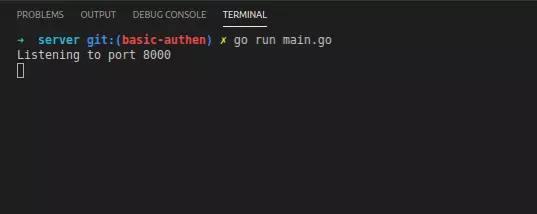
Tested by PostMan
- Sign Up Success

Check in the database to see if there is a record?
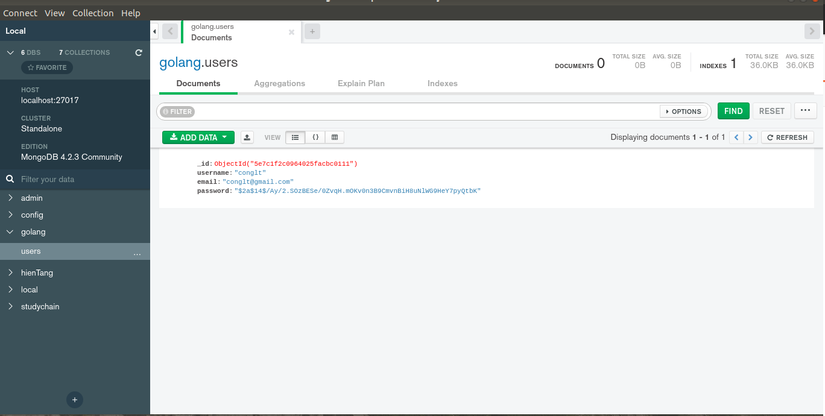
- Registration failed due to duplicate information (return status 409)
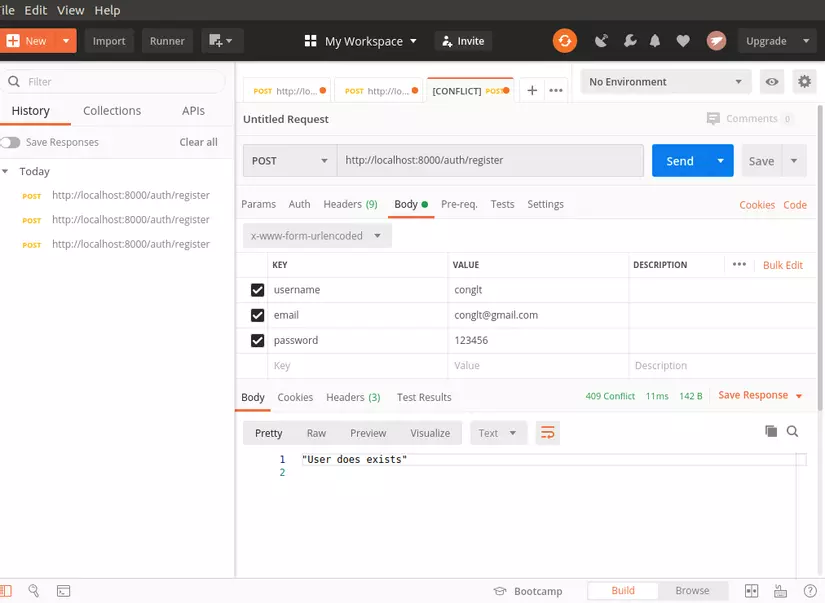
- Registration failed due to missing or incorrect information (return status 400)
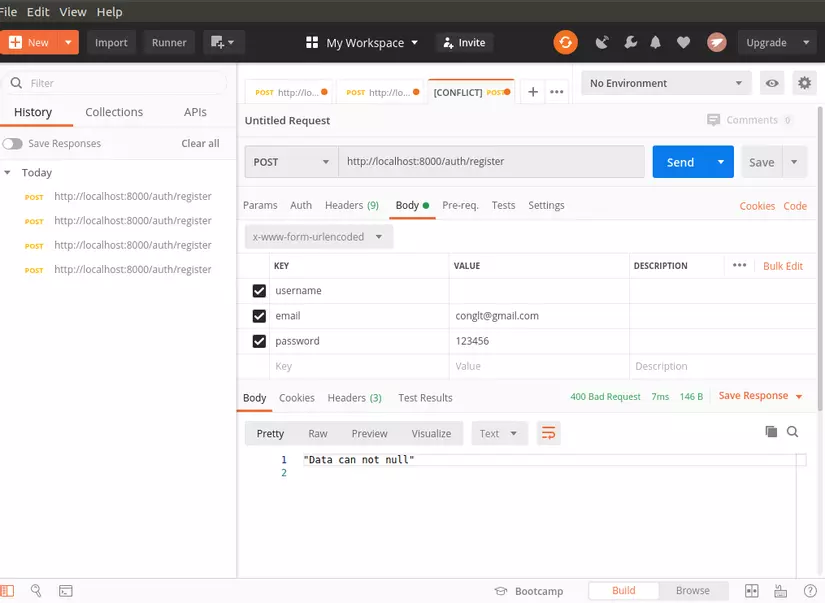
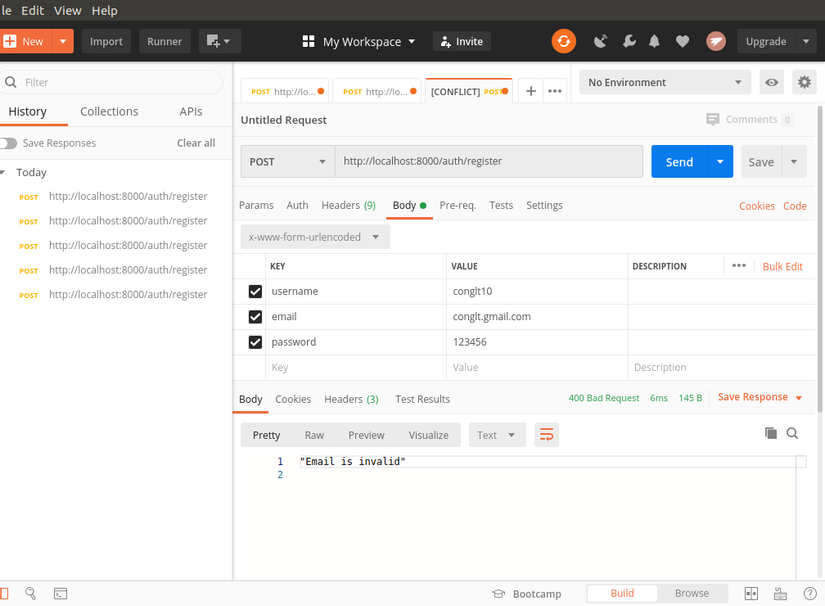
auth/jwt.go : Create jsonwebtoken
With the login function, we will use json web token, when the user successfully logs in, the server will return 1 token, the client will save the token (to localStorage for example) and send it to the server for subsequent requests. to identify users without having to log in again.
1 2 3 4 5 6 7 8 9 10 11 12 13 14 15 16 17 | <span class="token keyword">package</span> jwt <span class="token keyword">import</span> <span class="token punctuation">(</span> <span class="token string">"os"</span> <span class="token string">"time"</span> jwt <span class="token string">"github.com/dgrijalva/jwt-go"</span> <span class="token punctuation">)</span> <span class="token keyword">func</span> <span class="token function">Create</span> <span class="token punctuation">(</span> username <span class="token builtin">string</span> <span class="token punctuation">)</span> <span class="token punctuation">(</span> <span class="token builtin">string</span> <span class="token punctuation">,</span> <span class="token builtin">error</span> <span class="token punctuation">)</span> <span class="token punctuation">{</span> claims <span class="token operator">:=</span> jwt <span class="token punctuation">.</span> MapClaims <span class="token punctuation">{</span> <span class="token punctuation">}</span> claims <span class="token punctuation">[</span> <span class="token string">"authorized"</span> <span class="token punctuation">]</span> <span class="token operator">=</span> <span class="token boolean">true</span> claims <span class="token punctuation">[</span> <span class="token string">"username"</span> <span class="token punctuation">]</span> <span class="token operator">=</span> username claims <span class="token punctuation">[</span> <span class="token string">"exp"</span> <span class="token punctuation">]</span> <span class="token operator">=</span> time <span class="token punctuation">.</span> <span class="token function">Now</span> <span class="token punctuation">(</span> <span class="token punctuation">)</span> <span class="token punctuation">.</span> <span class="token function">Add</span> <span class="token punctuation">(</span> time <span class="token punctuation">.</span> Hour <span class="token operator">*</span> <span class="token number">12</span> <span class="token punctuation">)</span> <span class="token punctuation">.</span> <span class="token function">Unix</span> <span class="token punctuation">(</span> <span class="token punctuation">)</span> <span class="token comment">//Token hết hạn sau 12 giờ</span> token <span class="token operator">:=</span> jwt <span class="token punctuation">.</span> <span class="token function">NewWithClaims</span> <span class="token punctuation">(</span> jwt <span class="token punctuation">.</span> SigningMethodHS256 <span class="token punctuation">,</span> claims <span class="token punctuation">)</span> <span class="token keyword">return</span> token <span class="token punctuation">.</span> <span class="token function">SignedString</span> <span class="token punctuation">(</span> <span class="token punctuation">[</span> <span class="token punctuation">]</span> <span class="token function">byte</span> <span class="token punctuation">(</span> os <span class="token punctuation">.</span> <span class="token function">Getenv</span> <span class="token punctuation">(</span> <span class="token string">"SECRET_JWT"</span> <span class="token punctuation">)</span> <span class="token punctuation">)</span> <span class="token punctuation">)</span> <span class="token punctuation">}</span> |
We will use the jwt-go library to create json web token, the token will be encrypted according to the secret key stored in .env .
routes/auth.go : Login
1 2 3 4 5 6 7 8 9 10 11 12 13 14 15 16 17 18 19 20 21 22 23 24 25 26 27 28 29 30 31 32 33 34 35 36 37 38 39 40 41 42 | <span class="token keyword">func</span> <span class="token function">Login</span> <span class="token punctuation">(</span> w http <span class="token punctuation">.</span> ResponseWriter <span class="token punctuation">,</span> r <span class="token operator">*</span> http <span class="token punctuation">.</span> Request <span class="token punctuation">,</span> <span class="token boolean">_</span> httprouter <span class="token punctuation">.</span> Params <span class="token punctuation">)</span> <span class="token punctuation">{</span> username <span class="token operator">:=</span> r <span class="token punctuation">.</span> <span class="token function">PostFormValue</span> <span class="token punctuation">(</span> <span class="token string">"username"</span> <span class="token punctuation">)</span> password <span class="token operator">:=</span> r <span class="token punctuation">.</span> <span class="token function">PostFormValue</span> <span class="token punctuation">(</span> <span class="token string">"password"</span> <span class="token punctuation">)</span> <span class="token keyword">if</span> govalidator <span class="token punctuation">.</span> <span class="token function">IsNull</span> <span class="token punctuation">(</span> username <span class="token punctuation">)</span> <span class="token operator">||</span> govalidator <span class="token punctuation">.</span> <span class="token function">IsNull</span> <span class="token punctuation">(</span> password <span class="token punctuation">)</span> <span class="token punctuation">{</span> res <span class="token punctuation">.</span> <span class="token function">JSON</span> <span class="token punctuation">(</span> w <span class="token punctuation">,</span> <span class="token number">400</span> <span class="token punctuation">,</span> <span class="token string">"Data can not null"</span> <span class="token punctuation">)</span> <span class="token keyword">return</span> <span class="token punctuation">}</span> username <span class="token operator">=</span> models <span class="token punctuation">.</span> <span class="token function">Santize</span> <span class="token punctuation">(</span> username <span class="token punctuation">)</span> password <span class="token operator">=</span> models <span class="token punctuation">.</span> <span class="token function">Santize</span> <span class="token punctuation">(</span> password <span class="token punctuation">)</span> collection <span class="token operator">:=</span> db <span class="token punctuation">.</span> <span class="token function">Connect</span> <span class="token punctuation">(</span> <span class="token punctuation">)</span> <span class="token keyword">var</span> result bson <span class="token punctuation">.</span> M err <span class="token operator">:=</span> collection <span class="token punctuation">.</span> <span class="token function">FindOne</span> <span class="token punctuation">(</span> context <span class="token punctuation">.</span> <span class="token function">TODO</span> <span class="token punctuation">(</span> <span class="token punctuation">)</span> <span class="token punctuation">,</span> bson <span class="token punctuation">.</span> M <span class="token punctuation">{</span> <span class="token string">"username"</span> <span class="token punctuation">:</span> username <span class="token punctuation">}</span> <span class="token punctuation">)</span> <span class="token punctuation">.</span> <span class="token function">Decode</span> <span class="token punctuation">(</span> <span class="token operator">&</span> result <span class="token punctuation">)</span> <span class="token keyword">if</span> err <span class="token operator">!=</span> <span class="token boolean">nil</span> <span class="token punctuation">{</span> res <span class="token punctuation">.</span> <span class="token function">JSON</span> <span class="token punctuation">(</span> w <span class="token punctuation">,</span> <span class="token number">400</span> <span class="token punctuation">,</span> <span class="token string">"Username or Password incorrect"</span> <span class="token punctuation">)</span> <span class="token keyword">return</span> <span class="token punctuation">}</span> <span class="token comment">// convert interface to string</span> hashedPassword <span class="token operator">:=</span> fmt <span class="token punctuation">.</span> <span class="token function">Sprintf</span> <span class="token punctuation">(</span> <span class="token string">"%v"</span> <span class="token punctuation">,</span> result <span class="token punctuation">[</span> <span class="token string">"password"</span> <span class="token punctuation">]</span> <span class="token punctuation">)</span> err <span class="token operator">=</span> models <span class="token punctuation">.</span> <span class="token function">CheckPasswordHash</span> <span class="token punctuation">(</span> hashedPassword <span class="token punctuation">,</span> password <span class="token punctuation">)</span> <span class="token keyword">if</span> err <span class="token operator">!=</span> <span class="token boolean">nil</span> <span class="token punctuation">{</span> res <span class="token punctuation">.</span> <span class="token function">JSON</span> <span class="token punctuation">(</span> w <span class="token punctuation">,</span> <span class="token number">401</span> <span class="token punctuation">,</span> <span class="token string">"Username or Password incorrect"</span> <span class="token punctuation">)</span> <span class="token keyword">return</span> <span class="token punctuation">}</span> token <span class="token punctuation">,</span> errCreate <span class="token operator">:=</span> jwt <span class="token punctuation">.</span> <span class="token function">Create</span> <span class="token punctuation">(</span> username <span class="token punctuation">)</span> <span class="token keyword">if</span> errCreate <span class="token operator">!=</span> <span class="token boolean">nil</span> <span class="token punctuation">{</span> res <span class="token punctuation">.</span> <span class="token function">JSON</span> <span class="token punctuation">(</span> w <span class="token punctuation">,</span> <span class="token number">500</span> <span class="token punctuation">,</span> <span class="token string">"Internal Server Error"</span> <span class="token punctuation">)</span> <span class="token keyword">return</span> <span class="token punctuation">}</span> res <span class="token punctuation">.</span> <span class="token function">JSON</span> <span class="token punctuation">(</span> w <span class="token punctuation">,</span> <span class="token number">200</span> <span class="token punctuation">,</span> token <span class="token punctuation">)</span> <span class="token punctuation">}</span> |
- The part that takes data from the form request and validate is similar to the one we have in the
Registerfunction. - The database query (FindOne) is different from the
Decodefunction in the back. TheDecodefunction will convert the query data back to a map, making it easier to get the hash of the password at the back. For example, the result variable after FindOne will look like this.
1 2 | <span class="token keyword">map</span> <span class="token punctuation">[</span> _id <span class="token punctuation">:</span> <span class="token function">ObjectID</span> <span class="token punctuation">(</span> <span class="token string">"5e7c1f2c0964025facbc0111"</span> <span class="token punctuation">)</span> email <span class="token punctuation">:</span> <a class="__cf_email__" href="/cdn-cgi/l/email-protection">[email protected]</a> <span class="token punctuation">.</span> com password <span class="token punctuation">:</span> $ <span class="token number">2</span> a$ <span class="token number">14</span> $ <span class="token operator">/</span> Ay <span class="token operator">/</span> <span class="token number">2.</span> SOzBESe <span class="token operator">/</span> <span class="token number">0</span> ZvqH <span class="token punctuation">.</span> mOKv0n3B9CmvnBiH8uNlWG9HeY7pyQtbK username <span class="token punctuation">:</span> conglt <span class="token punctuation">]</span> |
- Next, call the
CheckPasswordHashfunction to see if the password sent from the client when hashed is the same as the password stored in the db? - Finally, call the
jwt.Createfunction to generate tokens, we also do not forget to check for possible errors.
Test with Postman
- Logged in successfully

- Wrong password

- The username does not exist in the db


